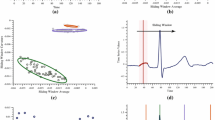Abstract
A burst, i.e., an unusally high frequency of an event in a time-window, is interesting in monitoring systems as it often indicates abnormality. While the detection of bursts is well addressed, the question of what “critical” thresholds, on the number of events as well as on the window size, make a window “unusally bursty” remains a relevant one. The range of possible values for either threshold can be very large. We formulate finding the combination of critical thresholds as a 2D search problem and design efficient deterministic and randomized divide-and-conquer heuristics. For both, we show that under some weak assumptions, the computational overhead in the worst case is logarithmic in the sizes of the ranges. Our simulations show that on average, the randomized heuristic beats its deteministic counterpart in practice.
Access this chapter
Tax calculation will be finalised at checkout
Purchases are for personal use only
Preview
Unable to display preview. Download preview PDF.
Similar content being viewed by others
References
Kleinberg, J.M.: Bursty and hierarchical structure in streams. Data Mining and Knowledge Discovery 7(4), 373–397 (2003)
Kumar, R., Novak, J., Raghavan, P., Tomkins, A.: On the bursty evolution of blogspace. In: WWW, pp. 568–576 (2003)
Lahiri, B., Akrotirianakis, I., Moerchen, F.: Finding critical thresholds for defining bursts in event logs, http://home.eng.iastate.edu/~bibudh/techreport/burst_detection.pdf
Vlachos, M., Meek, C., Vagena, Z., Gunopulos, D.: Identifying similarities, periodicities and bursts for online search queries. In: SIGMOD Conference, pp. 131–142 (2004)
Wang, X., Zhai, C., Hu, X., Sproat, R.: Mining correlated bursty topic patterns from coordinated text streams. In: KDD, pp. 784–793 (2007)
Xu, K., Zhang, Z.L., Bhattacharyya, S.: Reducing unwanted traffic in a backbone network. SRUTI (2005)
Yuan, Z., Jia, Y., Yang, S.: Online burst detection over high speed short text streams. In: ICCS, pp. 717–725 (2007)
Zhang, L., Guan, Y.: Detecting click fraud in pay-per-click streams of online advertising networks. In: ICDCS (2008)
Zhang, X., Shasha, D.: Better burst detection. In: ICDE, p. 146 (2006)
Zhu, Y., Shasha, D.: Efficient elastic burst detection in data streams. In: KDD, pp. 336–345 (2003)
Author information
Authors and Affiliations
Editor information
Editors and Affiliations
Rights and permissions
Copyright information
© 2011 Springer-Verlag Berlin Heidelberg
About this paper
Cite this paper
Lahiri, B., Akrotirianakis, I., Moerchen, F. (2011). Finding Critical Thresholds for Defining Bursts. In: Cuzzocrea, A., Dayal, U. (eds) Data Warehousing and Knowledge Discovery. DaWaK 2011. Lecture Notes in Computer Science, vol 6862. Springer, Berlin, Heidelberg. https://doi.org/10.1007/978-3-642-23544-3_37
Download citation
DOI: https://doi.org/10.1007/978-3-642-23544-3_37
Publisher Name: Springer, Berlin, Heidelberg
Print ISBN: 978-3-642-23543-6
Online ISBN: 978-3-642-23544-3
eBook Packages: Computer ScienceComputer Science (R0)




